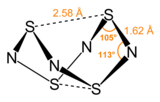|
Tetrasulfur tetranitride
Tetrasulfur tetranitride is an inorganic compound with the formula S4N4. This vivid orange, opaque, crystalline explosive is the most important binary sulfur nitride, which are compounds that contain only the elements sulfur and nitrogen. It is a precursor to many S-N compounds and has attracted wide interest for its unusual structure and bonding.[1][2] Nitrogen and sulfur have similar electronegativities. When the properties of atoms are so highly similar, they often form extensive families of covalently bonded structures and compounds. Indeed, a large number of S-N and S-NH compounds are known with S4N4 as their parent. StructureS4N4 adopts an unusual "extreme cradle" structure, with D2d point group symmetry. It can be viewed as a derivative of a (hypothetical) eight-membered ring (or more simply a 'deformed' eight-membered ring) of alternating sulfur and nitrogen atoms. The pairs of sulfur atoms across the ring are separated by 2.586 Å, resulting in a cage-like structure as determined by single crystal X-ray diffraction.[3] The nature of the transannular S–S interactions remains a matter of investigation because it is significantly shorter than the sum of the van der Waals radii[4] but has been explained in the context of molecular orbital theory.[1] One pair of the transannular S atoms have valence 4, and the other pair of the transannular S atoms have valence 2.[citation needed] The bonding in S4N4 is considered to be delocalized, which is indicated by the fact that the bond distances between neighboring sulfur and nitrogen atoms are nearly identical. S4N4 has been shown to co-crystallize with benzene and the C60 molecule.[5] PropertiesS4N4 is stable to air. It is, however, unstable in the thermodynamic sense with a positive enthalpy of formation of +460 kJ/mol. This endothermic enthalpy of formation originates in the difference in energy of S4N4 compared to its highly stable decomposition products:
S4N4 is shock and friction sensitive and because one of its decomposition products is a gas, it is considered a primary explosive.[1][6] Purer samples tend to be more sensitive.[7] Small samples can be detonated by striking with a hammer. S4N4 is thermochromic, changing from pale yellow below −30 °C to orange at room temperature to deep red above 100 °C.[1] SynthesisS4N4 was first prepared in 1835 by M. Gregory by the reaction of disulfur dichloride with ammonia,[8] a process that has been optimized:[9]
Coproducts of this reaction include heptasulfur imide (S7NH) and elemental sulfur, and the latter equilibrates with more S4N4 and ammonium sulfide:[10]
A related synthesis employs [NH4]Cl instead:[1]
An alternative synthesis entails the use of (((CH3)3Si)2N)2S as a precursor with pre-formed S–N bonds. (((CH3)3Si)2N)2S is prepared by the reaction of lithium bis(trimethylsilyl)amide and SCl2.
The (((CH3)3Si)2N)2S reacts with the combination of SCl2 and SO2Cl2 to form S4N4, trimethylsilyl chloride, and sulfur dioxide:[11]
Acid-base reactions S4N4 is a Lewis base at nitrogen. It binds to strong Lewis acids, such as SbCl5 and SO3, or H[BF4]:
The cage is distorted in these adducts.[1] S4N4 reacts with metal complexes, but the bonding situation may be quite complex. The cage remains intact in some cases but in other cases, it is degraded.[2][12] For example, the soft Lewis acid CuCl forms a coordination polymer:[1]
Reportedly, [Pt2Cl4(P(CH3)2Ph)2] initially forms a complex with S4N4 at sulfur. This compound, upon standing, isomerizes to additionally bond through a nitrogen atom. S4N4 oxidatively adds to Vaska's complex ([Ir(Cl)(CO)(PPh3)2] to form a hexacoordinate iridium complex where the S4N4 binds through two sulfur atoms and one nitrogen atom.[2] Dilute NaOH hydrolyzes S4N4 as follows, yielding thiosulfate and trithionate:[1]
More concentrated base yields sulfite:
As a precursor to other S-N compoundsMany S-N compounds are prepared from S4N4.[13] In electrophilic substitution or 1,3-dipolar cycloaddition reactions, S4N4 behaves as a combination of the dithionitronium synthon and the sulfide synthon. Thus it adds to arenes and electron-rich alkynes to give 1,2,5‑thiadiazoles.[14] Electron-poor alkynes attack S4N4 to give a different cycloadduct of stoichiometry RC(NS)2SCR′.[15][14] With electron-rich alkenes, S4N4 behaves as a Diels-Alder diene.[14] Passing gaseous S4N4 over silver metal yields the low temperature superconductor polythiazyl or polysulfurnitride (transition temperature (0.26±0.03) K[16]), often simply called "(SN)x". In the conversion, the silver first becomes sulfided, and the resulting Ag2S catalyzes the conversion of the S4N4 into the four-membered ring S2N2, which readily polymerizes.[1]
Oxidation of S4N4 with elemental chlorine gives thiazyl chloride,[citation needed] but milder reagents give S4N+
That cation is relatively non-electrophilic and planar, with a delocalized π system. However, it adds triphenylphosphine to give [S(NPPh3)3]3+[Cl−]3, a triimide analogue to sulfur trioxide. Conversely, S4N+ Treatment with tetramethylammonium azide produces the similar 10-π heterocycle [S3N3]−:
In a related reaction, the use of the bis(triphenylphosphine)iminium azide gives a salt containing the blue [NS4]− anion:[13]
[NS4]− has a chain structure approximated by the resonance [S=S=N−S−S−] ↔ [−S−S−N=S=S]. Reaction with piperidine generates [S4N5]−:
A related cation is also known, i.e. [S4N5]+. Triphenylphosphine abstracts a sulfur atom, replacing it with another triphenylphosphine moiety:[14]
SafetyS4N4 is a categorized as a primary explosive that is shock and friction sensitive. While comparable to pentaerythritol tetranitrate (PETN) in terms of impact sensitivity, its friction sensitivity is equal to or even lower than lead azide.[17] Purer samples are more shock-sensitive than those contaminated with elemental sulfur.[9][7] Related compounds
References
|
||||||||||||||||||||||||||||||||||||||||||||


